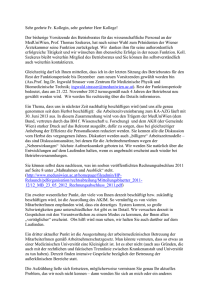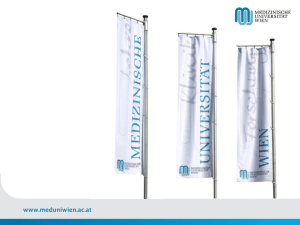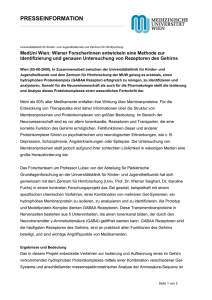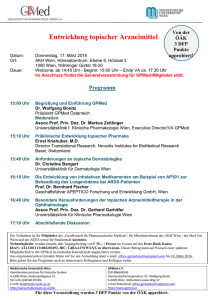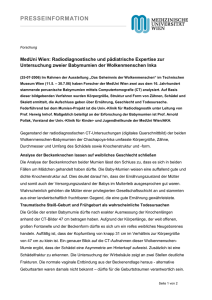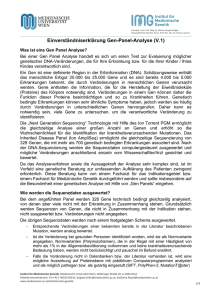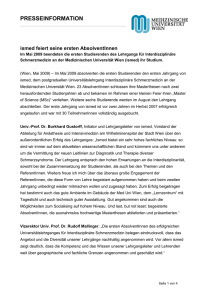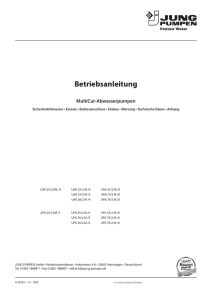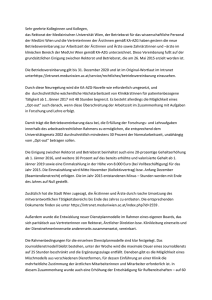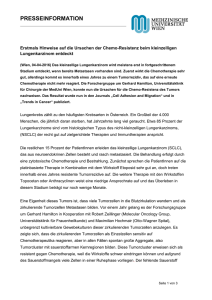Frühes Zervixkarzinom - Fortbildungstagung für Gynäkologie und
Werbung
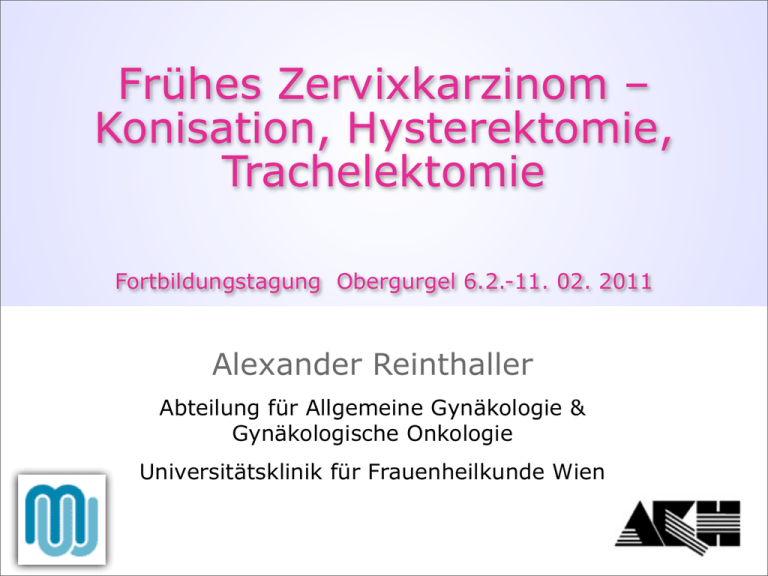
Frühes Zervixkarzinom – Konisation, Hysterektomie, Trachelektomie Fortbildungstagung Obergurgel 6.2.-11. 02. 2011 Alexander Reinthaller Abteilung für Allgemeine Gynäkologie & Gynäkologische Onkologie Universitätsklinik für Frauenheilkunde Wien FIGO Stadien I IA IA1 IA2 IB Auf den Uterus beschränkt Diagnose nur mikroskopisch, alle makroskopischen Tumore sind IB, Invasion ≤ 5mm, horizontale Ausdehnung ≤ 7mm, LVSI ändert Stadium nicht Invasion ≤ 3mm, horizontale Ausdehnung ≤ 7mm Invasion 3-5mm, horizontale Ausdehnung ≤ 7mm Makroskopisch sichtbarer Tumor oder „mikroskopischer“ Tumor größer als IA IB1 ≤ 4cm IB2 > 4cm [email protected] http://www.gynonko.at UFK WIEN Diagnose ● Wie wahrscheinlich diagnostiziert man ein mikroinvasives Karzinom vor der Konisation? ● 105 Fälle: 98 Fälle Ia1, 7 Fälle Ia2 ● In 15.2% präoperativ bekannt ► In 7 Fällen präoperativ durch Biopsie entdeckt (davon in 3 Fällen PAP V) ► in 9 Fällen PAP V und Biopsie ≤ CIN III ● Vergleiche: Kolstad et al. 32.6% ● Meistens Zufallsbefund ! [email protected] http://www.gynonko.at UFK WIEN Diagnose ● Wie wahrscheinlich diagnostiziert man ein Karzinom nach Konisation, wenn die Vor-befunde keine invasive Läsion zeigen (kein PAP V, PE kein invasives Karzinom)? ● 1944 Fälle: Malignitätswahrscheinlichkeit: 4.8% ● Ia1=79 (4.06%) ● Ia2=10 (0.05%) ● Ib=13 (0.6%) ● N. endometrii=1 (0,005%) [email protected] http://www.gynonko.at UFK WIEN Diagnose ● Wie wahrscheinlich diagnostiziert man ein Karzinom nach der Konisation, wenn vor der Konisation eine bioptisch verifizierte CIN II/III bestand ? ● 935 Fälle: Malignitätswahrscheinlickeit: 6.9% ► Ia1=55 (5.9%) ► Ia2=3 (0.3%) ► Ib=7 (0.7%) [email protected] http://www.gynonko.at UFK WIEN Schlussfolgerungen ● Mikroinvasives Karzinom oft Zufallsbefund!!!! ● Diagnose meist erst nach Konisation bekannt ● Falls präoperativ bereits bekannt Konisation zum Staging ev. zur Therapie notwendig [email protected] http://www.gynonko.at UFK WIEN Therapeutische Ziele ● Indvidualisierte und stadiengerechte Behandlung durch individuelle Risikoeinschätzung ► Tumorstadium Infiltrationstiefe, Oberflächenausdehnung ► Prognosefaktoren Infiltrationstiefe, LVSI (Lympho-Vascular Space Involvement) = Gefäßeinbrüche [email protected] http://www.gynonko.at UFK WIEN Therapeutische Ziele ● Indvidualisierte und stadiengerechte Behandlung durch individuelle Risikoeinschätzung ► Tumorstadium Infiltrationstiefe, Oberflächenausdehnung ► Prognosefaktoren Infiltrationstiefe, LVSI (Lympho-Vascular Space Involvement) = Gefäßeinbrüche Optimale therapeutische Wirkung Minimum an intra- und postoperativer Morbidität [email protected] http://www.gynonko.at UFK WIEN Wie häufig ist LVSI ? ● Kolstad et al. 1989 ► < 1mm Infiltrationstiefe: 2.2% ► 1-3 mm Infiltrationstiefe: 13.4% ● Ostor AG. 1995 ► < 1mm Infiltrationstiefe: 1.1% ► 1-3 mm: 18% ● FIGO 1A2 ► 3-5 mm Infiltrationstiefe 19-23% [email protected] http://www.gynonko.at UFK WIEN Wie häufig sind LKNMetastasen? ● LVSI negativ ● Ostor AG. 1995: ► < 1mm Infiltrationstiefe: 0.9% ► 1-3 mm Infiltrationstiefe: 1.1% ► 3-5 mm Infiltrationstiefe: 5.1% ● Marchetti et al.: IA1: 1.1% ● Argenta et al.: IA1: 0.8% ● Zusammenfassung: LVSI negativ, FIGO IA1 ► Risiko für LKN Metastasen: ca. 1% [email protected] http://www.gynonko.at UFK WIEN Wie häufig sind LKNMetastasen? ● LVSI positiv ● Ostor AG. 1995: ► < 1mm Infiltrationstiefe: 3.2% ► 1-3 mm Infiltrationstiefe: 3.3% ► 3-5 mm Infiltrationstiefe: 5.6% Vergleiche IA2: LVSI neg: 5.1% ● Zusammenfassung: LVSI pos, FIGO IA1: ► Risiko für LKN Metastasen: ca. 3% ► Für IA2: Information betreff LVSI nicht zwingend erforderlich [email protected] http://www.gynonko.at UFK WIEN Wie häufig sind Rezidive? ● Ostor AG. 1995: ► IA overall: LVSI+: Rezidiv: 9.3% LVSI-: Rezidiv: 0.6% ● < 1mm Infiltrationstiefe: LVSI unbekannt ► Ostor: 0.2%, Kolstad: 1.2% ● 1-3 mm Infiltrationstiefe: LVSI unbekannt ► Ostor: 1.7%, Kolstad: 3.1% ● 3-5 mm Infiltrationstiefe: LVSI unbekannt ► Ostor: 3.7%, Kolstad: 4.3% [email protected] http://www.gynonko.at UFK WIEN LKN-Metastasen, Rezidive, Todesfälle bei mikroinvasivem Zervixkarzinom Stromainvasion N Patienten + LKN Rezidiv Tod FSI 1409 0% 0.3 % 0.07 % < 1mm 2274 0.1 % 0.4 % 0.1 % 1-3 mm 1324 0.4 % 1.7 % 0.5 % 674 2.1 % 3.7 % 1.9 % 3.1-5 mm FSI – Frühe Stromainvasion [email protected] Ostor AG et al. 1995 http://www.gynonko.at UFK WIEN Mikroinvasives Zervixkarzinom Standardtherapie ● Stadium IA1 ► Konisation im Gesunden oder einfache abdominale/vaginale Hysterektomie ► Keine Lymphadenektomie wenn LVSI negativ Aufklärung über ca. 1% LKN Metastasen ► Pelvine Lymphadenektomie wenn LVSI positiv paraaortal nur wenn pelvin positiv Skip Metastasen praktisch 0% [email protected] http://www.gynonko.at UFK WIEN Mikroinvasives Zervixkarzinom Standardtherapie ● Stadium IA2 ► Auf jeden Fall pelvine Lymphadenektomie PLUS ► Modifiziert radikale Hysterektomie oder Piver II ► Einfache Hysterektomie ► Radikale Trachelektomie ► Einfache Trachelektomie ? ► Konisation in sano [email protected] http://www.gynonko.at UFK WIEN Re-Operation ? ● Invasiver Anteil non in sano: ► Re-Operation auf jeden Fall erforderlich ► Richtige Stadieneinteilung! ● Invasiver Anteil in sano, CIN in sano: ► Risiko für Restdysplasie: 0.0% ► Re-Operation nicht erforderlich ● Invasiver Anteil in sano, CIN am RR: ► Risiko für multifokales Zervixkarzinom: 3.1% ► Risiko für CIN II-III: 37.5% ► Re-Operation sinnvoll [email protected] http://www.gynonko.at UFK WIEN FIGO Stadien I IA IA1 IA2 IB Auf den Uterus beschränkt Diagnose nur mikroskopisch, alle makroskopischen Tumore sind IB, Invasion ≤ 5mm, horizontale Ausdehnung ≤ 7mm, LVSI ändert Stadium nicht Invasion ≤ 3mm, horizontale Ausdehnung ≤ 7mm Invasion 3-5mm, horizontale Ausdehnung ≤ 7mm Makroskopisch sichtbarer Tumor oder „mikroskopischer“ Tumor größer als IA IB1 ≤ 4cm IB2 > 4cm [email protected] http://www.gynonko.at UFK WIEN FIGO Stadien I IA IA1 IA2 IB Auf den Uterus beschränkt Diagnose nur mikroskopisch, alle makroskopischen Tumore sind IB, Invasion ≤ 5mm, horizontale Ausdehnung ≤ 7mm, LVSI ändert Stadium nicht Invasion ≤ 3mm, horizontale Ausdehnung ≤ 7mm Invasion 3-5mm, horizontale Ausdehnung ≤ 7mm Makroskopisch sichtbarer Tumor oder „mikroskopischer“ Tumor größer als IA IB1 ≤ 4cm IB2 > 4cm [email protected] http://www.gynonko.at UFK WIEN Standardtherapie beim frühen invasiven Zervixkarzinom ● Pelvine Lymphadenektomie ► Periaortale Lymphadenektomie bei positiven pelvinen Lymphknoten ● Radikale Hysterektomie ► Piver II (Wertheim) ► Piver III ► Nervenschonende Techniken [email protected] http://www.gynonko.at UFK WIEN Fertilitätserhaltende chirurgische Therapie ● Mikroinvasives Zervixkarzinom ► Konisation in sano ► Einfache Trachelektomie ● Stadium IB1 ► Radikale Trachelektomie [email protected] http://www.gynonko.at UFK WIEN Radikale Trachelektomie ● Radikale Entfernung der Zervix ca. ● ● ● ● ● 5 mm unterhalb des inneren MM Entfernung der Parametrien Scheidenmanschette Pelvine Lymphadenektomie Cerclage und vaginozervikale Anastomose Mögliche Techniken ► Laparoskopisch-assistierte vaginale (LAVRT) oder abdominale radikale Trachelektomie (ART) [email protected] http://www.gynonko.at UFK WIEN Vaginale radikale Trachelektomie [email protected] http://www.gynonko.at UFK WIEN Vaginale radikale Trachelektomie ● LAVRT (Dargent D et al., Gynecol Oncol 1994; 52:105) ● >600 Fälle beschrieben ● Indikationen ► Invasives Zervixkarzinom ► Tumorgröße <=2cm, Zervixlänge >=2cm ► Kein endozervikaler Tumor ► Kein Hinweis auf Organüberschreitung oder Metastasierung ► Entsprechender vaginaler Zugang ► Fertilitätswunsch [email protected] http://www.gynonko.at UFK WIEN Onkologische Ergebnisse LAVRT [email protected] http://www.gynonko.at UFK WIEN Onkologische Ergebnisse LAVRT 8 Studien – Plante M, Gynecol Oncol 2008; 111:S105 N Patientinnen Mediane Nachkontrolle (Mo) Rezidivrate Tod 603 21-95 27 (4.5%) 15 (2.5%) [email protected] http://www.gynonko.at UFK WIEN Onkologische Ergebnisse LAVRT 8 Studien – Plante M, Gynecol Oncol 2008; 111:S105 N Patientinnen Mediane Nachkontrolle (Mo) Rezidivrate Tod 603 21-95 27 (4.5%) 15 (2.5%) ● Rezidivlokalisationen ► 40% Lokalrezidive ► 25% Lymphknotenrezidive ● Ungenügende Parametrienresektion, distante parametrane LKN-Metastasen [email protected] http://www.gynonko.at UFK WIEN Risikofaktoren für ein Rezidiv (LAVRT) [email protected] http://www.gynonko.at UFK WIEN Risikofaktoren für ein Rezidiv (LAVRT) ● Tumorgröße >=2cm vs. >2cm – 1.6% vs. 29% Rezidivrate (Marchiole et al., Gynecol Oncol 2007; 106:132) [email protected] http://www.gynonko.at UFK WIEN Risikofaktoren für ein Rezidiv (LAVRT) ● Tumorgröße >=2cm vs. >2cm – 1.6% vs. 29% Rezidivrate (Marchiole et al., Gynecol Oncol 2007; 106:132) ● LVSI (ja/nein) – 12% vs. 2% (Marchiole et al., Gynecol Oncol 2007; 106:132) [email protected] http://www.gynonko.at UFK WIEN Risikofaktoren für ein Rezidiv (LAVRT) ● Tumorgröße >=2cm vs. >2cm – 1.6% vs. 29% Rezidivrate (Marchiole et al., Gynecol Oncol 2007; 106:132) ● LVSI (ja/nein) – 12% vs. 2% (Marchiole et al., Gynecol Oncol 2007; 106:132) ● 10-12% - ausgedehnter endozervikaler Tumor, LKN-Metastasen, Parametrienbefall, positive Schnittränder (Marchiole et al., Gynecol Oncol 2007; 106:132; Shepard et al., BJOG 2006;113:719; Beiner et al., Nat Clin Pract Oncol 2007; 4:353) [email protected] http://www.gynonko.at UFK WIEN Risikofaktoren für ein Rezidiv (LAVRT) ● Tumorgröße >=2cm vs. >2cm – 1.6% vs. 29% Rezidivrate (Marchiole et al., Gynecol Oncol 2007; 106:132) ● LVSI (ja/nein) – 12% vs. 2% (Marchiole et al., Gynecol Oncol 2007; 106:132) ● 10-12% - ausgedehnter endozervikaler Tumor, LKN-Metastasen, Parametrienbefall, positive Schnittränder (Marchiole et al., Gynecol Oncol 2007; 106:132; Shepard et al., BJOG 2006;113:719; Beiner et al., Nat Clin Pract Oncol 2007; 4:353) Patientenselektion [email protected] http://www.gynonko.at UFK WIEN Geburtshilfliche Ergebnisse LAVRT [email protected] http://www.gynonko.at UFK WIEN Geburtshilfliche Ergebnisse LAVRT N Patientinnen 256 Abbruch, EU 14 (5%) Abortus - 1. Trimester 47(18%) Abortus - 2. Trimester 22 (8.6%) Entbindungen 158 (62%) Entbindungen < SSW 32 18 (12%) Entbindungen SSW 32-37 26 (16%) Entbindungen >SSW 37 Laufende Schwangerschaften 102 (65%) 15 (6%) 8 Studien – Plante M, Gynecol Oncol 2008; 111:S105 [email protected] http://www.gynonko.at UFK WIEN LAVRT-Limitationen [email protected] http://www.gynonko.at UFK WIEN LAVRT-Limitationen ● Selten durchgeführte Technik ► Frequenz- und Ausbildungsproblem [email protected] http://www.gynonko.at UFK WIEN LAVRT-Limitationen ● Selten durchgeführte Technik ► Frequenz- und Ausbildungsproblem ● Kleine Tumore (<=2cm) [email protected] http://www.gynonko.at UFK WIEN LAVRT-Limitationen ● Selten durchgeführte Technik ► Frequenz- und Ausbildungsproblem ● Kleine Tumore (<=2cm) ● Eingeschränkte Radikalität Parametrienresektion [email protected] http://www.gynonko.at UFK WIEN LAVRT-Limitationen ● Selten durchgeführte Technik ► Frequenz- und Ausbildungsproblem ● Kleine Tumore (<=2cm) ● Eingeschränkte Radikalität Parametrienresektion Abdominale radikale Trachelektomie (ART) [email protected] http://www.gynonko.at UFK WIEN ART – Resektionslinien [email protected] http://www.gynonko.at UFK WIEN ART – Resektionslinien Innerer Muttermund A. und V. uterina N. splanchnici Resektionslinie Trachelektomie N. hypogastricus Beckenwand Piver II Piver III Nervenschonend [email protected] Ureter http://www.gynonko.at UFK WIEN ART - Technik [email protected] http://www.gynonko.at UFK WIEN ART - Technik [email protected] http://www.gynonko.at UFK WIEN ART - Technik [email protected] http://www.gynonko.at UFK WIEN ART - Technik [email protected] http://www.gynonko.at UFK WIEN Schwangerschaft nach ART [email protected] http://www.gynonko.at UFK WIEN LAVRT versus ART [email protected] http://www.gynonko.at UFK WIEN LAVRT versus ART ● Beide Techniken für den Fertilitätserhalt ● geeignet Vorteile der LAVRT ► Weniger invasiv ► Bessere Datenlage zu onkologischen und geburtshilflichen Ergebnissen ● Vorteile der ART ► Standardtechnik der radikalen HE anwendbar ► Entsprechende Ausbildung gewährleistet ► Größere Radikalität wenn erforderlich [email protected] http://www.gynonko.at UFK WIEN Zukunftsaspekte [email protected] http://www.gynonko.at UFK WIEN Zukunftsaspekte ● Stellenwert der neoadjuvanten Chemotherapie ● Ultrakonservative Chirurgie ► Ausgedehnte Konisation bzw. einfache Trachelektomie ► Stadium IA2 ► Sog. kleines Stadium IB1 Tumorvolumen? [email protected] http://www.gynonko.at UFK WIEN Zukunftsaspekte ● Stellenwert der neoadjuvanten E K N A Chemotherapie ● Ultrakonservative Chirurgie ► Ausgedehnte Konisation bzw. D einfache Trachelektomie ► Stadium IA2 ► Sog. kleines Stadium IB1 Tumorvolumen? [email protected] http://www.gynonko.at UFK WIEN
